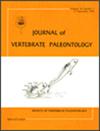Early Cretaceous radiation of teleosts recorded by the otolith-based ichthyofauna from the Valanginian of Wąwał, central Poland
IF 1.9
4区 地球科学
Q2 PALEONTOLOGY
引用次数: 0
Abstract
ABSTRACT We report a Valanginian (Early Cretaceous) otolith-based ichthyofauna from a section at Wąwał in central Poland. We describe one new genus (Palaeoargentina gen. nov.), six new otolith-based species (Pteralbula polonica sp. nov., Protalbula pentangularis sp. nov., Kokenichthys kuteki sp. nov., Protoelops gracilis sp. nov., Palaeoargentina plicata sp. nov., Archaeotolithus aptychoides sp. nov.) from Wąwał and compare them to species known from similar assemblages elsewhere. The comparison of teleost diversity shows similarity to the Aptian (late Early Cretaceous) and less distinctly to the Maastrichtian (latest Cretaceous) assemblages, rather than to its coeval equivalents from Germany and southern England, and indicates that a considerable teleost diversity already existed before the mid-Cretaceous. The vertical succession of otolith taxa in the Wąwał section is in concordance to the pattern already revealed from the succession of bivalves and other benthic invertebrates and it is attributed to sea level and temperature variations. Previously identified causes of benthic invertebrate succession in the Wąwał section are used to infer paleoenvironmental factors governing fish distribution in the Valanginian marine environment recorded at this site. The new findings suggest that the radiation of teleosts started before the Valanginian, and it was a relatively long and apparently gradual process. This fossil association also reveals a significant shift in the abundance ratio of fish otoliths vs. cephalopod statoliths in fully marine deposits, with otoliths much more abundant than the statoliths in Valanginian and younger sediments while it is otherwise in the Jurassic deposits.波兰中部Wąwał的Valanginian的以耳石为基础的鱼组所记录的早白垩世硬鱼鱼的辐射
本文章由计算机程序翻译,如有差异,请以英文原文为准。
求助全文
约1分钟内获得全文
求助全文
来源期刊
CiteScore
2.90
自引率
7.10%
发文量
58
审稿时长
4-8 weeks
期刊介绍:
The Journal of Vertebrate Paleontology publishes original contributions on all aspects of vertebrate paleobiology, including vertebrate origins, evolution, functional morphology, taxonomy, biostratigraphy, phylogenetics, paleoecology, paleobiogeography, and paleoanthropology. JVP publishes high quality peer-reviewed original articles, occasional reviews, and interdisciplinary papers. It is international in scope, and emphasizes both specimen- and field-based based research and the use of high-quality illustrations. Priority is given to articles dealing with topics of broad interest to the entire vertebrate paleontology community and to high-impact specialist studies. Articles dealing with narrower topics, including notes on taxonomic name changes (unless these deal with errors published in JVP), preliminary site reports, and documentation of new specimens of well-known taxa, are afforded lower priority.

 求助内容:
求助内容: 应助结果提醒方式:
应助结果提醒方式:


